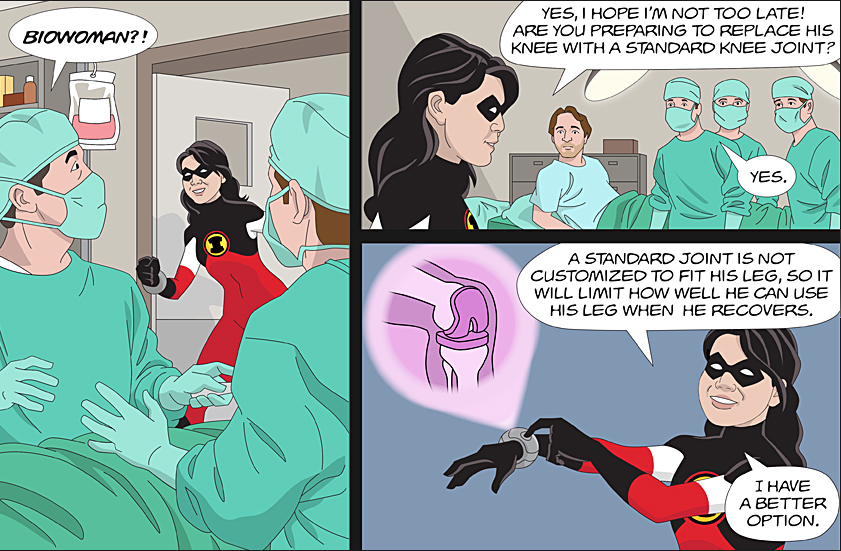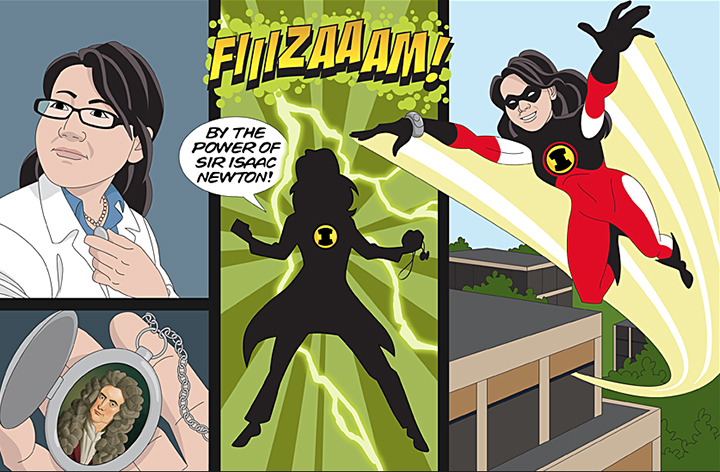By day, Lijie “Grace” Zhang is an assistant professor in the George Washington University School of Engineering and Applied Science. But by night, she is BioWoman—a quick-thinking superhero who saves the career of an Olympic athlete, using one of the most cutting-edge technologies in complex tissue engineering.
Dr. Zhang is the latest SEAS faculty member to star in the school’s series of online comic strips, which explain real-world research through fictional storylines. The two-year-old marketing campaign, called IMPACT, is a light-hearted take on topics that are often presented in fairly dry formats, said SEAS Dean David Dolling—who has made an appearance in each of the five IMPACT episodes.
“The idea behind this entire project is that engineers can be thought of as a type of real-life superhero,” he said. “Advances brought about through biomedical engineering are the obvious example, but better communications technologies, safer infrastructure and transportation systems, cleaner environments and other technologies developed by engineers also help save lives.”
The IMPACT team spawned from the imagination of SEAS Director of Communications Joanne Welsh in 2009 and was used in a booklet produced for the school’s 125th anniversary celebration. The first comic subsequently premiered in April 2012. After choosing a professor to highlight, she—along with SEAS web developer Adam Casper and former social media developer Sam Smith, B.A. ’12—would brainstorm storylines, careful to ensure that the scientific details were absolutely accurate.
“We would share our ideas with the professor, who would tell us what was on track and what wasn’t. Sam would put together the first version of the script, and then he and I would refine it from there,” Ms. Welsh said.
After a final script is created, Ms. Welsh works with graphic designer Brian Cox and professional illustrator Cedric Hahnstadt to bring the superheroes to life. The entire process can take a few months from idea to conception, but the finished products are well worth the effort.
Since the premier of the first episode, the IMPACT comic has generated a significant amount of Internet buzz. It has been featured on various STEM and engineering blogs, as well as received shout-outs on social media from a number of colleges and professional organizations, such as the American Society of Engineering Education, Imperial College London, the Massachusetts Institute of Technology, STEMconnector and Tel Aviv University, to name a few.

Set in the year 2030, the latest IMPACT episode tells the story of U.S. Olympic skier (real-life SEAS web developer) Adam Casper, who shatters his knee in a bicycling accident. When doctors attempt to replace his knee with a standard joint, Dr. Zhang transforms into BioWoman and swoops into the hospital. Using a 3D printer, BioWoman is able to create an exact duplicate of his joint, allowing him to optimize the use of his new knee. After surgery and rehabilitation, the Olympian goes on to win gold.
It may sound like the makings of a sci-fi film, but the comic is based on the very real research of Dr. Zhang, the director of GW’s Bioengineering Laboratory for Nanomedicine and Tissue Engineering.
While simple tissue can be relatively easy to repair, the regeneration of complex tissue—such as bone, cartilage and muscle—is much more challenging. 3D bioprinting is a less costly, more effective alternative to traditional tissue regeneration methods. To begin the process, adult stem cells are taken from the patient’s bone marrow and cultured for about a week. Then, MRIs are taken in order to construct a 3D model of a patient’s joint. When enough cells are grown, the 3D machine prints the joint, and it is inserted back into the patient.
The technique offers greater precision to control the internal architecture of a scaffold and to print complicated, continuous structures. The method also allows the scaffold to perfectly integrate with the wound site, which expedites tissue regeneration and reduces the patient’s recovery time.
“3D bioprinting is a totally novel field,” Dr. Zhang said. “It’s a very promising method because we can very quickly create a custom-designed, patient-specific tissue organ substitute. Traditional techniques cannot do that.”
While the technique is still in its testing phases, Dr. Zhang said 3D printers could be approved for joint repair within the next decade, having the potential to revolutionize modern-day medicine.
In the mean time, Dr. Dolling said he is hoping that the SEAS IMPACT team is helping to make engineering accessible to a broad audience and may attract prospective students to the field.
“The comics help dispel the idea that engineering is ‘uncool.’ We want young, prospective engineers to see themselves in our superheroes, and what could be cooler than saving lives?”


